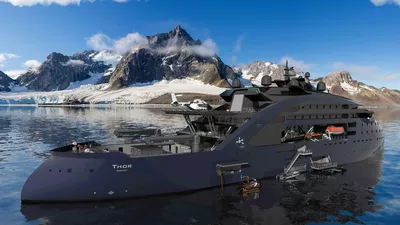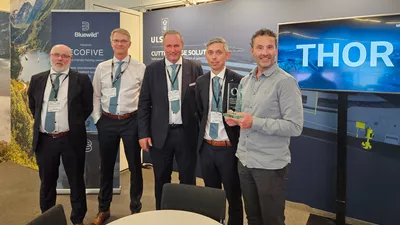What if...
The development of ULSTEIN THOR started with a simple question: "What if…" With an idea free of technological and regulatory restrictions, the design team began to play around with different end scenarios. What if we can build a vessel with an abundant emission-free energy source and support other vessels with clean fuel?
The ULSTEIN THOR concept is still ahead of its time regarding what is technologically possible and within maritime laws and regulations. We believe that the future is something we need to create, and in that respect, ULSTEIN THOR is an important first step in pushing for progress in the industry.

Electrifying the seas
When realised, the ULSTEIN THOR design concept will serve as a mobile power and charging station, marking a new era by introducing a new breed of full-electric vessel operations. The 149m long vessel is categorised as a Replenishment, Research, and Rescue (3R) vessel. The plan is to equip the vessel with a Small Modular Reactor (SMR) or a Thorium Molten Salt Reactor (MSR) to generate 20 MW of clean, safe electricity. The ULSTEIN THOR design is not just a mobile power source but also has the potential to integrate into the renewable energy grid, thereby bolstering the power network.
Navigating the nuclear power challenges in maritime operations
When the technology is available and hurdles are overcome, the ULSTEIN THOR replenishment vessel can generate clean energy and is poised to be a game changer for decarbonising shipping operations. By installing a heat source/reactor, it addresses key challenges such as the availability and cost of alternative fuels and the large storage volume requirements.
This vessel charges other vessels with clean energy, minimising the need for specialised personnel, and reduces the number of vessels carrying nuclear fuel. This approach leads to more competitive energy prices through economies of scale.

Hurdles to overcome when introducing Thorium power:
- Reactor effect/size:
Often, these are too large for the energy demand of a single vessel. - Expertise availability:
There is a limited pool of professionals to operate and maintain the reactors. - Regulatory limitations:
Different flag states impose various restrictions, affecting port accessibility.
Power demand fluctuations on vessels pose a challenge, particularly for the commercial viability of MSRs on vessel types primarily operating at low loads. These challenges can be solved by placing the reactor on a single vessel that can replenish other vessels.
Further ahead in time, by developing a plan for energy exchange between ships and land-based networks, these fluctuations can be managed. Another viable solution is to harness surplus energy to produce e-fuels or similar alternatives.

Enabling fully electric cruise vessels in Antarctic waters
ULSTEIN THOR was originally conceived as a replenishment vessel for expedition cruise ships operating in the Antarctic waters from October to March. Over 50 cruise vessels embark on expedition tours in the Antarctic peninsula during this period. To demonstrate the commercial viability of this concept, we introduced ULSTEIN SIF alongside ULSTEIN THOR. ULSTEIN SIF, a full-electric expedition cruise ship concept, is intended to operate on par with other cruise ships.

ULSTEIN SIF will, when crossing the Drake Passage between Antarctica and Ushuaia, typically consume about 130 MWh of energy on a two-day operation. While in Antarctica, the energy consumption decreases to approximately 100 MWh for a five-day trip.
With these figures in mind, we have devised a charging schedule for a fully electric vessel. This includes two offshore recharges per round trip – one upon arrival at Antarctica and another before the return journey through the Drake Passage, plus a final recharge at the port in Ushuaia. ULSTEIN SIF's battery will be charged with 100 kWh during each of the two recharges in Antarctica.

Each cruise vessel set to be refilled will spend six hours charging from ULSTEIN THOR. THOR is designed to charge one cruise vessel at a time, with a total capacity to charge four vessels per day (4 x 6 hours charge).
Given THOR's dimensioning criteria and the typical schedule of cruise vessels operating in Antarctica, THOR could provide energy for up to 15 small cruise expedition vessels per season. Extrapolating this schedule to a typical 150-day operation, we find that the daily energy replenishment demand for the vessel ranges between 200 and 300 MWh.
The power demand of ULSTEIN THOR will be driven by the receiving vessel's recharge capacity, which will fluctuate significantly throughout the day and its operation. THOR's power plant needs to be flexible to accommodate these changes. A realistic dimensioning for the reactor is 20 MWe at peak capacity, allowing for the supply of peak capacity, own consumption, and a marginal excess for potential additional needs. With a 20 MWe reactor, the power plant could be complemented by four 5MWe closed-loop steam turbines, allowing the reactor's power output to be easily adapted to different levels of operation.
Early discussions with classification societies have underscored the need for a redundant energy source. As such, two sets of marine generator sets are also included in the power plant. This complementary power plant does not need to cater to the full power capacity of the vessel but rather supplies power to critical and essential systems only.

Raising awareness and discovering new possibilities
Several innovative ideas in ULSTEIN THOR are novel to the maritime industry, and it is crucial to thoroughly compare different reactor types, security measures, energy forms, and energy technologies. At present, we may not possess all the answers, but with enhanced knowledge and a comprehensive assessment of the value chain, this project is within reach. The THOR, serving as a facilitator and enabler, is projected to be constructed within an estimated 10-15 years, possibly even sooner.
As an initial step, Ulstein has developed an energy infrastructure that includes a fully electric cruise vessel. The reactor technology is housed on a separate vessel, the ULSTEIN THOR, which is an enabler. This approach could pave the way towards zero emissions and offer increased energy independence, particularly in light of the current macro-political climate.
Ulstein collaborates with research institutions, the nuclear power industry, flag states, classification authorities, port authorities, and various policymakers. Our goal is to foster a more comprehensive understanding of this domain.

Getting closer to realisation
As we progress towards fully electric vessels, we have already addressed many challenges. These challenges primarily concern energy access and infrastructure.
The future of reactor technology leans towards small, compact units suitable for use on board ships. Given the prerequisites of reactors scaled to the shipping industry's sizes and the establishment of business units capable of owning, operating, maintaining, and, importantly, decommissioning the reactors, implementation could be relatively straightforward.
Ulstein is a global and innovative provider of marine operations. Fuelled by creative enthusiasm, we strive to combine skills, knowledge, and creativity to devise new concepts, solutions, and products that will propel the maritime sector into the future. However, industry transformation hinges on knowledge and collaboration. Therefore, we must unite our efforts across industries in turning visions into reality.





